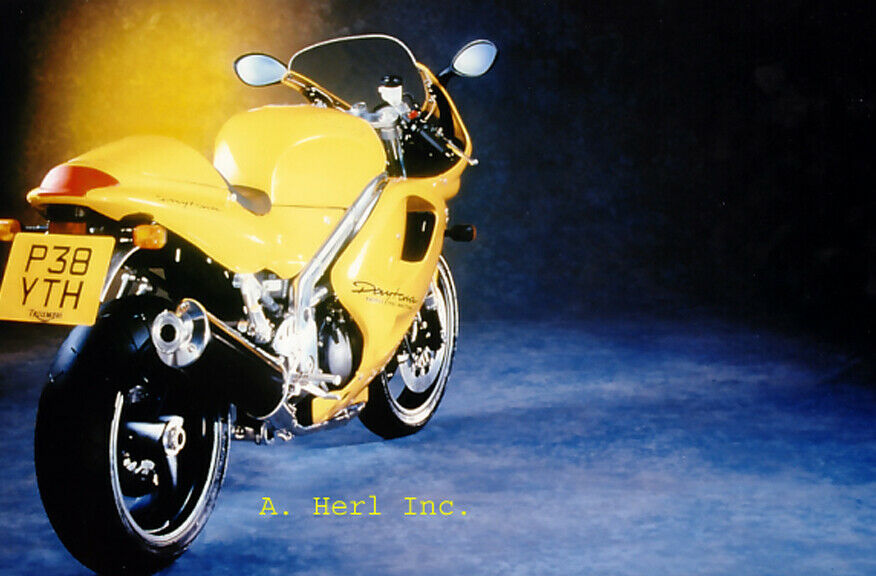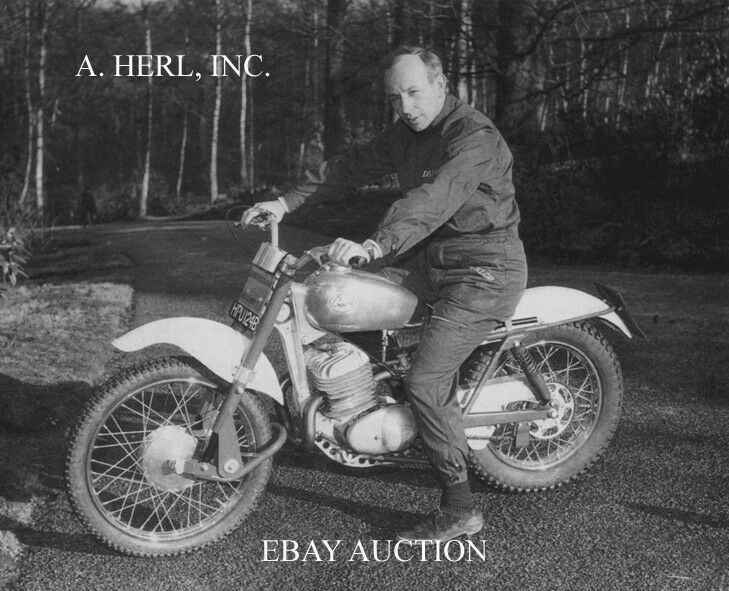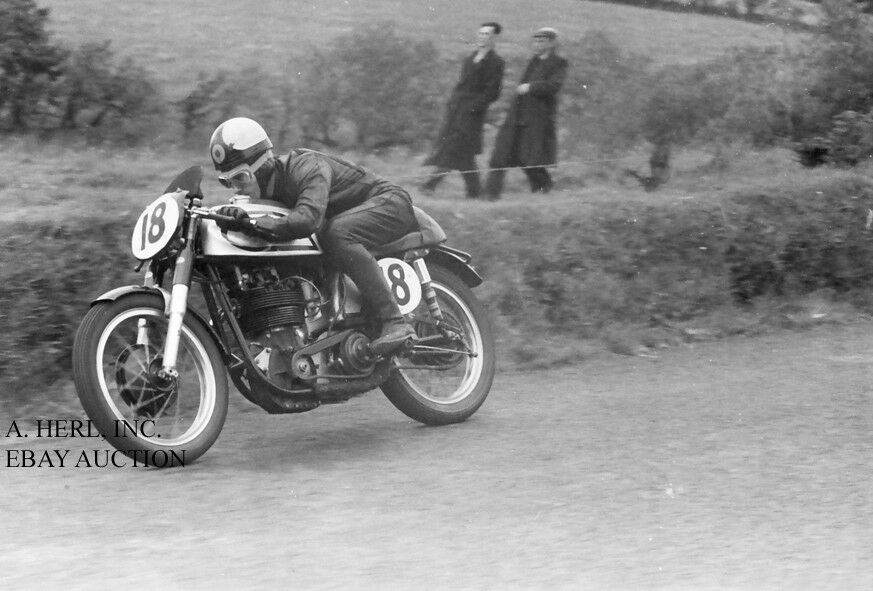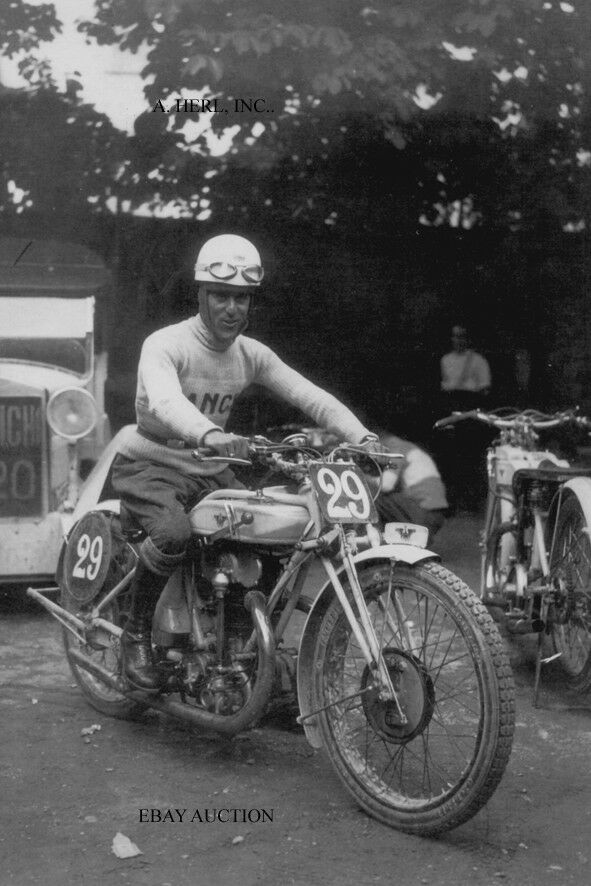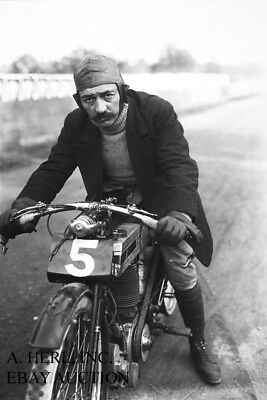-40%
Indian 1913 8-valve 61 ci Hendee Manufacturing motorcycle sidecar press photo
$ 5.14
- Description
- Size Guide
Description
A superb and rare photo the Hendee Manufacturing sidecar motorcycle combination from1913
motorcycle Photo.
The absolutely magnificent
Indian 8-valve (!!!) 61 c.i. (1,000cc) V-twin
was introduced in 1911 and was produced until 1918. Indian placed it on sale to the public at the astronomical price of 0. It featured overhead-valve heads with four valves per cylinder, and was easily capable of speeds of over 120 mph. In various forms, it was raced on the dirt track as well as on the boards with very great success. It is unknown how many of the 8-valve racers were manufactured, but production was very small indeed; most machines were ridden either by factory riders or were "loaned" to promising privateers. Like the other board track bikes of its era, it lacks such amenities as brakes, a clutch, or even a throttle (carbs were run wide open, with the only control of the engine speed being an ignition cut-out). The Indian 8-valve V-twin racers were very successful on the wooden board tracks that ruled racing in the beginning of the 20TH century in the
USA
and
Europe
. Bicycle racing on banked, wooden velodromes was enormously popular at the turn of the 20th century. Many of the very first machines identifiable as motorcycles were built by bicycle mechanics, and were used as "pacers" to train bicycle racers. The first race probably occurred the first time that two of them happened to be on the track at the same time. Indian’s Oscar Hedstrom was one of these enterprising young mechanics, and his design was so elegant and reliable that it was produced in quantity by the Hendee Manufacturing Company as the first Indian motorcycle. Timber was cheap, labor was plentiful, and board track racing offered a level of spectacle not seen since Roman times. With the help of an engineer from
New Jersey
by the name of Jack Prince -- who sought to build a chain of large tracks from coast to coast -- board track races spread across the nation like wildfire. The Coliseum in Los Angeles, over a quarter mile long, was opened in 1909, followed immediately by a one-third mile bowl in Springfield, Mass., and in 1910 by full mile-long tracks in Playa del Rey, California (a suburb wedged between Los Angeles and the Pacific ocean) and Salt Lake City, Utah. Tracks up to two miles in length were thrown up in 1911 in
Oakland
,
Denver
,
Buffalo
,
Cleveland
,
Chicago
, and
Detroit
. 1912 brought tracks to
Milwaukee
,
Omaha
,
Houston
,
Cleveland
and
Atlantic City
. Race promoters made wads of money, with ,000 daily gate receipts a common draw. Very high speeds and a complete lack of safety precautions lead to spectacular wrecks on the board tracks in the 1910s, often killing a half-dozen competitors and spectators at a time. Controversy over safety had already caused the national sanctioning organization to switch the 1913 National Championship Races over from the boards to the safer, but less profitable, dirt ovals. True to form, racing improved the breed. Motorcycles went from able-to-keep-up-with-bicycles in 1900 to the first 100-mph average lap, turned by Lee Humiston on a "Big-Valve" Excelsior at the Playa del Rey track in 1912. Technical competition among the manufacturers was just as fierce as the racing itself. The race for prestige led famous manufacturers like Indian, Excelsior, Cyclone, Thor, and Flying Merkel to develop purpose-built racing equipment with the highest attainable horsepower they could squeeze from their motors. Few were as successful in doing this then Indian was!
Indian
is the oldest motorcycle marque currently in production in the
USA
. They were manufactured from 1901 to 1953 in
Springfield
,
Massachusetts
. Indian was initially known as the Hendee Manufacturing Company but was later renamed the Indian Motocycle Manufacturing Company. The Indian factory team took the first three places in the 1911 Isle of Man Tourist Trophy. During the 1910s Indian became the largest manufacturer of motorcycles in the world. Indians most popular models were the Scout, made from 1920 to 1946, and the Chief, made from 1922 to 1953. The Indian Motocycle Manufacturing Company went bankrupt in 1953. Between 1953 and the early 1970s, different organizations imported motorcycles into the
United States
and applied the Indian logo to them, with varying degrees of legitimacy. The rights to the Indian marque were reconciled in the late 1990s and were acquired by Indian Motorcycle Company of
America
, which began building new Indian motorcycles in
Gilroy
,
California
in 1999. The Indian Motorcycle Company of
America
went bankrupt and ceased production in 2003. Rights to the Indian marque were acquired by the Indian Motorcycle Company of
Kings Mountain
,
North Carolina
in 2006.
This is a very nice and very rare non period photo that reflects a wonderful era of Indian
motocycle
history in a wonderful way. This is your rare chance to own this photo, therefore it is printed in a nice large format of ca. 8" x 10" (ca. 20 x 25.4 cm). It makes it perfectly suitable for framing!
Contact us for more Indian and other motorcycle photos of the old and famous American and European motorcycle brands and save on shipping!
Shipping costs will only be $ 7.00 regardless of how many photos you buy. For 5 or more photos, shipping is free!
(Note: A. Herl, Inc. does not appear on photo, for ebay purposes only)
No copyright expressed or implied. Sold as collectable item only. We are clearing out our archives that we have gathered from various sources.
All items always sent well protected in PVC clear files
and board backed envelopes.
We have photographs that came from professional collections and/or were bought from the original photographer or press studio! They are all of professional and excellent quality.
After many decades of professionally collecting photographs and posters we are clearing out our archives. They make the perfect gift and are perfectly suited for framing. They will look gorgeous unframed and will be a true asset nicely framed with a border. They are a gorgeous and great asset in every home, workshop, workplace, restaurant, bar or club!
First come - first served. And you can always contact us for your requests. Please ask any questions before the auction ends.


